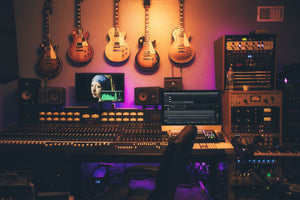The COVID-19 pandemic has had a significant impact on many aspects of daily life, including the way we consume and create music. With lockdowns and social distancing measures in place, people have been spending more time at home, leading to an increase in the popularity of music production.
One of the biggest changes brought about by the pandemic is the shift towards online music production. With traditional recording studios closed or operating at reduced capacity, many musicians and producers have turned to digital platforms to create and share their music. This has led to a surge in the use of digital audio workstations (DAWs) such as Ableton Live and FL Studio, as well as virtual instruments and effects. These tools have made it possible for musicians to continue creating music from the safety of their homes, even when in-person collaboration is not possible.

"With traditional recording studios closed or operating at reduced capacity, many musicians and producers have turned to digital platforms to create and share their music."
THE RISE OF THE BEDROOM STUDIO
The pandemic has led to an increase in the popularity of home recording for several reasons. With lockdowns and social distancing measures in place, many people have been spending more time at home, leading to an increase in the amount of free time available for hobbies and interests. For many people, this has included exploring their interest in music production.
As a result of this increased interest, there has been an increase in the sale of home recording equipment such as microphones, audio interfaces, and MIDI controllers. These tools allow individuals to record and produce music from the comfort of their own homes, without the need for expensive studio equipment or rental fees. This has made it more accessible and convenient for people to pursue their interest in music production.
Additionally, with more time spent at home, people have been more inclined to take online tutorials and courses to learn how to produce music. Online resources such as video tutorials, webinars and virtual classes have been a great way for amateur producers to learn the basics of music production and how to use various software and hardware. This has led to a growth in the number of amateur producers, as more people are now equipped with the knowledge and tools to create their own music.
In summary, the pandemic has led to an increase in the popularity of home recording as many people have been able to take advantage of the free time and the opportunity to explore their interests in music production. This has led to an increase in the sale of home recording equipment and a growth in the number of amateur producers, as people have been able to learn the basics of music production through online tutorials and courses.
THE RISE OF STREAMING
The pandemic has had a significant impact on the way music is consumed. With people spending more time at home due to lockdowns and social distancing measures, streaming services such as Spotify and Apple Music have seen a significant increase in usage. This is because streaming services provide a convenient way for people to access and listen to music while they are stuck at home.
As a result of this increased usage, streaming services have become an important platform for independent and unsigned artists to reach a wider audience.
These artists may not have the resources or connections to promote their music through traditional channels, but streaming services allow them to share their music with a global audience. This has led to an increase in the visibility of independent and unsigned artists, as more people are discovering new music through streaming services.
Additionally, the pandemic has led to an increase in the popularity of niche genres and subcultures. As people spend more time at home, they have been more inclined to discover new music and explore different styles. This has led to an increase in the popularity of niche genres such as lo-fi and experimental electronic music, as well as subcultures such as vaporwave and chillhop. Streaming services have played a key role in this, as they have made it easier for people to discover and listen to these niche genres and subcultures.
With people spending more time at home, streaming services have seen a significant increase in usage. This has led to an increase in the visibility of independent and unsigned artists, as well as the popularity of niche genres and subcultures. Streaming services have played a key role in this by making it easier for people to discover new music and explore different styles, leading to a more diverse and inclusive music landscape.
It's never been easier to release music
-
DistroKid is one of the most popular platforms for independent artists to upload and distribute their music to streaming services like Spotify, Apple Music, and Tidal. It is known for its affordable pricing and user-friendly interface.
-
TuneCore is another popular platform that allows independent artists to upload and distribute their music to various streaming services without the need for a record label. In addition to distribution, they also offer other services such as publishing administration, synch licensing and YouTube Monetization.
-
Amuse is a great option for independent artists who want to distribute their music to streaming services without a record label. Amuse is a mobile-first platform that also offers a free distribution option and a very user-friendly interface.
All three of these platforms allow artists to keep 100% of their royalties and control over their releases, and make it easy to get your music in front of a global audience through streaming services.

In conclusion, the COVID-19 pandemic has had a significant impact on the music industry. With lockdowns and social distancing measures in place, many musicians and producers have turned to digital platforms and home recording to continue creating music. The pandemic has also led to an increase in the popularity of live streaming and home recording, as well as a growth in the number of amateur producers. Additionally, it has led to a change in the way music is consumed, with streaming services becoming more popular and a more diverse and inclusive music landscape emerging.
As more and more people discover the creative possibilities of sample packs, it is likely that the industry will continue to grow in the coming years.


Comments